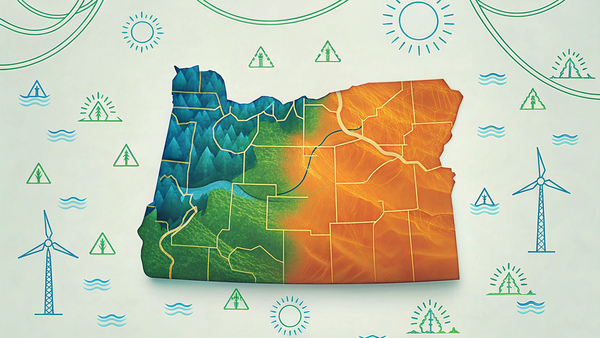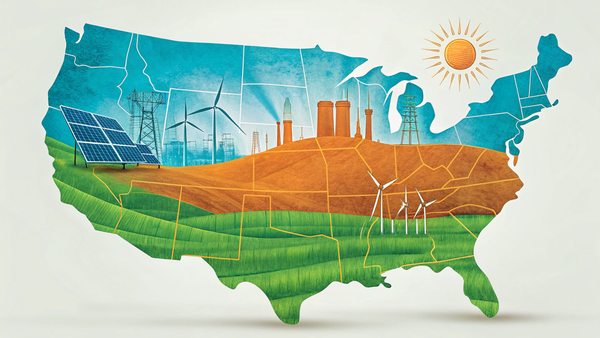Scaling the Exploration of Energy Systems
Hear from our founders about what we are currently developing at Evolved for release over the coming year.

Energy modeling today provides critical insights by exploring selected futures under carefully constructed scenarios. But as new questions get raised about the energy transition, the need to map a broader range of possibilities becomes clear. At Evolved Energy Research, we see the next evolution not just as improving individual scenarios, but as systematically scaling the exploration itself. This piece outlines how we are building toward that future: combining high-fidelity modeling, automated scenario generation, and AI-powered exploration to create a dynamic map of what the future could hold.
How to Explore an Energy System Transition
Traditional energy systems modeling faces significant challenges in producing robust and diverse scenarios for understanding the energy transition. Today’s methods are highly manual, labor-intensive, and heavily reliant on the expertise of seasoned modelers. For the Annual Decarbonization Perspective, for example, this starts with enumerating (what we perceive to be) the most important dimensions of the energy transition, for example, rates of electrification. Then our modeling team carefully designs an internally consistent scenario around the chosen narrative. Finally, a model like RIO is run to produce optimized solutions that illuminate to some of decarbonization's first order questions.
While this approach has produced critical insights, it has fundamentally limits in scalability. Each scenario requires extensive human input, and because human time and attention are finite, the number of futures explored remains relatively small. This bottleneck not only restricts the quantity of scenarios but also their diversity. Even expert modelers inevitably bring unconscious biases to the process, shining light only under the lamppost rather than venturing into less obvious but potentially transformative futures. In a world where deep uncertainty defines the energy transition, these limitations mean that many critical pathways could remain unexplored simply because they do not align with familiar narratives or what the modelers and stakeholders anticipate that they think they need.
Furthermore, differences between modeling results across firms are often attributed to variations in model architecture, cost assumptions, or input data; however, in practice, the deeper source of divergence often lies elsewhere: in the fundamental design of scenarios. Choices about which technologies are considered viable, what resource potentials are assumed accessible, and which policies are modeled—or omitted—can shape the boundaries of possibility more profoundly than marginal differences in costs or efficiencies.
Identify Key Model Outcomes
A. Identify Key Model Outcomes
This is the starting point where we brainstorm different model outcomes we'd like to see to paint a robust picture of potential futures. Low land use is prioritized here as a guiding constraint. This step is fundamentally a prioritization activity.
Design Scenario
B. Design Scenario
This is a manual process of establishing reasonable constraints on the model to direct the solver to a fundamentally unique solution. Land use limits are encoded here. This step requires expertise and is a common failure point in energy analyses.
Produce Comparative Results
C. Produce Comparative Results
Examine results for differences between Core or Central scenarios. In the low land use scenario we observe: Additional new nuclear, high reliance on rooftop solar, and reduced buildout of utility-scale wind and solar
Iterate or Narrate
D. Iterate or Narrate
If the scenario results are not compelling, we strengthen constraints. If compelling, we narrate both the scenario design and the impacts. In this case, the low land use narrative supports a more distributed energy future and the deployment of additional zero-carbon firm resources.
Ensemble: A Bold Alternative
While scenarios have long been a foundational tool in energy systems analysis—offering structured narratives and quantifiable pathways for exploring uncertainty—Evolved Energy Research has developed a next-generation methodology called Ensemble that builds on the strengths of scenarios while addressing their limitations. Instead of manually crafting each scenario, Ensemble automates the creation of thousands of unique solutions by finding scenarios that are maximally differentiated across outcomes but are nearly the same from an energy system cost perspective. Ensemble draws on work known as modeling-to-generate-alternatives (MGA), which deliberately explores a range of solutions that are close in cost or performance to the optimal but differ widely across other dimensions.
This multidimensional exploration enables Ensemble to generate a rich and diverse dataset of future energy system configurations. Rather than simply tweaking one or two parameters, Ensemble reshapes the modeling landscape, seeking to maximize differences across many axes. In doing so, it uncovers combinations that human modelers would not have the time—or perhaps even the imagination—to explore. A scenario that overbuilds renewables of a certain type and spikes curtailment may reveal something about necessary market design or procurement policy. Scenarios that choose sub-optimal resources from a cost perspective may be much more robust from a supply chain perspective when analyzed with that lens. High electrification may be the ambition in certain sectors, but we may fail to achieve this and should understand how to mitigate this failure. These are individual examples that we imagined, but importantly, Ensemble offloads the creative burden of scenario design from humans to compute resources, dramatically scaling the exploration of plausible energy futures. On the front end, modelers can thus redirect their efforts toward building a highly robust and richly detailed core model—the "kernel"—that can withstand the diverse stresses and variations that Ensemble will impose, and on the back end, modelers can interpret and apply the analyses with the human experience and intuition necessary to identify reasonable solutions in a complex social and political environment.
This evolution in approach redefines the role of the energy modeler. Instead of spending precious hours brainstorming and curating scenario narratives, modelers now focus on enhancing the depth and accuracy of the underlying model. That includes investing more effort into developing constraint sets that may not usually bind in traditional scenarios but could be critical under certain conditions; improving the technological richness and granularity of options available (especially those that are not chosen under traditional least-cost optimizations); and ensuring that input data for costs, performance, and resource availability are as representative and adaptable as possible. The goal is to prepare the model to answer questions we have not yet thought of asking.
Equally transformative is the shift Ensemble enables for consumers of modeling results. Historically, energy systems analysis has been opaque to non-experts. Consumers typically engage with a small handful of scenarios, and their intuition about how systems behave remains limited because they see only isolated snapshots, not the underlying dynamics. Ensemble changes this by creating large datasets of results that stakeholders can explore systematically. Instead of taking the output of a single model run as gospel, users can now interact with broad distributions, observing how key outcomes like emissions, costs, reliability, and technology deployments vary across different assumptions and constraints.
The Role of AI
The vast scale of Ensemble’s outputs introduces a new challenge: how to meaningfully explore and interpret thousands or tens of thousands of complex model runs. Here, we contend that artificial intelligence (AI) plays a central role. We are working to deploy AI methods—ranging from clustering algorithms to natural language summarization—to mine the Ensemble datasets, surface broad patterns, identify archetypal scenarios, and reveal hidden correlations that would otherwise be invisible. Instead of navigating endless spreadsheets, users interact with model results using natural language. AI thus acts not just as a navigator, but as a translator of Ensemble’s vast scenario space, allowing stakeholders to query the dataset interactively; receive statistically supported answers; and explore energy futures in ways that are intuitive, fast, and powerful.
Crucially, AI's role is not limited to mining data—it must be given context to understand the nuances of energy system dynamics, and this is where our modeling expertise becomes indispensable. Machine learning provides powerful technical tools, but energy modeling experience shapes how the AI interprets, organizes, and presents information. In practice, we guide the AI’s development through a series of targeted activities:
- Crafting detailed in-context ("inshot") prompts and examples that teach the AI how to summarize system behavior correctly.
- Embedding domain-specific priorities like system reliability, cost realism, and land-use constraints.
- Imparting higher-order energy transition reasoning patterns such as feedback loops, path dependencies, and resilience assessments.
Our involvement ensures that the AI highlights the most relevant, strategic insights—such as identifying bottlenecks, trade-offs, and no-regrets investments—rather than surfacing superficial or spurious results. In short, we are not simply using AI off-the-shelf; we are actively tailoring it to internalize the accumulated intuition, discipline, and insight of experienced energy system modelers. This partnership between modeling expertise and AI technology, leveraging our ensemble data, can be a true Rosetta Stone for understanding and navigating the energy transition.
Transparency and Collaboration: Troves of Open-Source Data
The broader strategic positioning of Ensemble reflects an ambition to move beyond the traditional model of publishing a few handpicked scenarios and instead toward curating large datasets for public, academic, and stakeholder use. These datasets, when combined with AI-driven exploration tools, offer both depth and breadth, providing a resource that researchers, policymakers, and other stakeholders can mine for developing insights, conducting analyses, and benchmarking progress over time.
The growing call for open-source energy models reflects a desire for greater transparency, reproducibility, and stakeholder trust in energy system analysis. However, simply making more models open or encouraging broader participation in modeling activities does not automatically solve the underlying challenges. Our view is that the future of trustworthy, accessible modeling is not about enabling more people to operate complex models with less expertise. Rather, it is about removing barriers to the production of a wider range of plausible scenarios, reducing the bias inherent in manual scenario design, and creating better ways for non-modelers to engage directly with the results.
Trust in modeling is not earned by exposing every technical detail or allowing anyone to build scenarios from scratch; it is earned by demonstrating consistent, interpretable behavior across a wide breadth of futures. Ensemble advances this goal by allowing stakeholders to observe how a high-fidelity, expert-built model behaves under diverse constraints and assumptions. This approach shifts the emphasis from isolated snapshots to statistical patterns, trade-offs, and sensitivities observed across large sets of outcomes. By empowering users to explore these results interactively, filter based on their priorities, and surface insights without having to re-engineer the underlying model, we strengthen transparency, reproducibility, and engagement—while preserving the rigor and discipline necessary for high-quality system analysis. In this way, Ensemble offers a pragmatic, scalable, and trust-building path forward in response to the broader open-source movement.
What could the future hold?
Today, most of our consulting engagements include a detailed technical report summarizing a handful of custom scenarios, supplemented by key policy insights and recommendations. These discrete scenarios will continue to play a critical role in our analytical offerings because they allow clients to ask discrete questions: what is the isolated impact of variable A on outcome B. This is the energy-modeling equivalent to following the scientific method. However, for exercises that are an attempt to explore a wide breadth of scenarios (our Annual Decarbonization Perspectives, Net-Zero America, Net-Zero Australia, Decarb America, etc.) Ensemble will allow us to deliver dynamic, flexible platforms that stakeholders can explore, personalize, and update over time, fundamentally changing how we support client decision-making.






